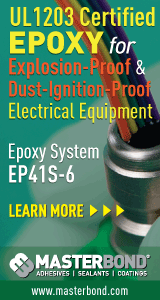|

|
|
| Ask the Experts | |||||||
|
|||||||
|
February 20, 2025 - Updated January 8, 2013 - Originally Posted Epoxy Wicking up Wire InsulationWe have 13 gauge insulated wires soldered directly into plated holes in a circuit board. The board is placed inside a plastic housing and filled/potted with epoxy. During the curing process, the epoxy "wicks" up the wire inside the insulation and hardens. This reduces the flexibility of the wire beyond the filled area. Can you suggest ways to eliminate the wicking of the epoxy up the wires so the wires remain flexible? T.J. |
|||||||
| Expert Panel Responses | |||||||
|
Higher Viscosity epoxy. Or softer hardness.
President Krayden Inc. Wayne Wagner has over 25 years in the conformal coating industry and is the president of Krayden Inc., a leading distributor of engineered materials.
You don't say how many wires per circuit board, or how many circuit boards you need to do this to, so the solution I suggest may not be practical. I saw this issue in an automotive components manufacturer who needed to pot the CCA inside of a plastic housing just to protect the electronics from the harsh under-the-hood environment, and they also had an issue with the loss of a flexible harness at the point where the wires exited the potting material. The good news is that there are potting materials that are cured instantly using UV radiation. A two-stage potting process can be used. In the first stage, an automatic dispenser can be used to dispense a fairly thick UV-curable potting component on top of the solder joint at the point where the insulation of the 13-gauge wire ends. Then the CCA is subsequently passed under the UV curing conveyor which flash-cures the first-stage potting, sealing the insulation before any has time to wick up the wire underneath the insulation.Then the entire CCA can be potted inside of its enclosure, and the first-stage potting prevents any of the second-stage potting material from wicking under the wire. CAUTION: Selection of the first-stage potting material requires qualification. It must be compatible with the solder joints,the insulation on the wires, and lastly the 2nd-stage(currently-used) potting material. For example, there are certain UV-curable RTV compounds that can be used, but they MUST be electronics-grade RTV materials, as some RTVs will attack solder joints. I suggest you talk to your current potting vendor if you haven't already. They may already have a solution to this issue, because this is not unique to your product. If they don't have a solution, contact the folks at one of the following companies. They both represent a large number of product lines, and both have experts available that can help you find a compatible solution. Just remember, qualify whatever product you choose. You may need to run some humidity testing as well as other testing to ensure the materials are indeed compatible and will withstand the environment in which your product is intended to be used. You don't want to trade your current problem with a worse one that does not manifest itself until much later! Contact the folks at one of the following companies for help: www.hisco.com/ and www.ellsworth.com
Advanced Engineer/Scientist General Dynamics Richard D. Stadem is an advanced engineer/scientist for General Dynamics and is also a consulting engineer for other companies. He has 38 years of engineering experience having worked for Honeywell, ADC, Pemstar (now Benchmark), Analog Technologies, and General Dynamics.
Heat-shrink sleeve would that work???
Technical Sales Manager BLT Circuit Services Ltd Greg York has over thirty two years of service in Electronics industry. York has installed over 600 Lead Free Lines in Europe with Solder and flux systems as well as Technical Support on SMT lines and trouble shooting.
Three opportunities present themselves:
The second option also may be feasible; if you are using an elevated-temperature curing process, the elevated temperature can drastically drop the viscosity of the un-cured potting material, which will dramatically increase wicking. Dropping the temperature of the curing process, at least until partial cure has been attained, may be a solution. If you are using a vacuum to de-gas after potting, this can also dramatically increase wicking. It may not be possible or desirable to eliminate the vacuum step, however. The third option is a sure fix, but requires an additional material, and potentially an additional curing step, to seal around the wires.
Process Engineer Astronautics Fritz's career in electronics manufacturing has included diverse engineering roles including PWB fabrication, thick film print & fire, SMT and wave/selective solder process engineering, and electronics materials development and marketing. Fritz's educational background is in mechanical engineering with an emphasis on materials science. Design of Experiments (DoE) techniques have been an area of independent study. Fritz has published over a dozen papers at various industry conferences.
|
|||||||
| Submit A Comment | |||||||
|
Comments are reviewed prior to posting. You must include your full name to have your comments posted. We will not post your email address. |
|
Free Newsletter Subscription
Circuitnet is built for professionals who bear the responsibility of looking ahead, imagining the future, and preparing for it. Insert Your Email Address |
|

|




